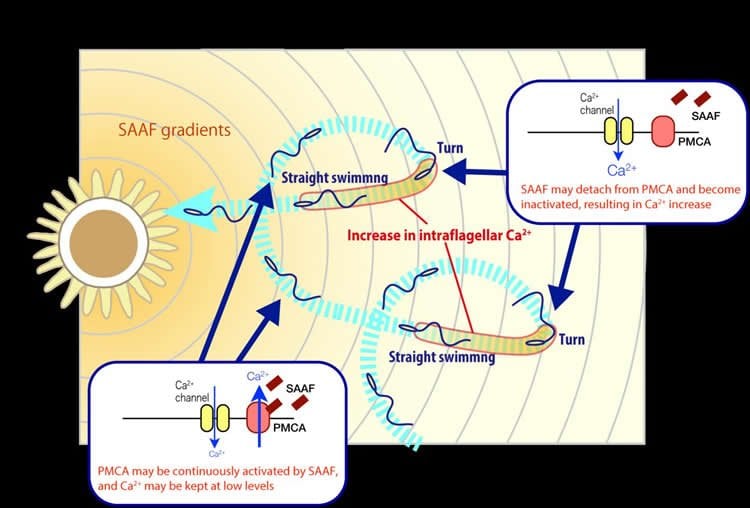Summary: Researchers have identified a specific protein in the cell membranes of sperm that help them navigate their way to the egg for fertilization.
Source: University of Tokyo.
Researchers have found that a protein in the cell membranes of sperm plays a key role in how they find their way to eggs. The PMCA protein may also help explain how egg cells only interact with sperm from the same species. PMCA may even be a target of drug discovery.
Sperm are excellent navigators. If they weren’t we wouldn’t even be here. Professor Manabu Yoshida from the Misaki Marine Biological Station at the University of Tokyo and colleagues investigate why sperm behave the way they do.
Sperm cells, bacteria and other microscopic organisms use varying concentrations of chemicals in their environment – concentration gradients – to approach or avoid something in a process called chemotaxis. Egg cells release an attractant chemical, which lures the sperm. The researchers studied this action in Ascidia – sea squirts, brainless tubular creatures, which are only mobile as larvae.
“We identified that a calcium transport protein – plasma membrane Ca2+ ATPase (PMCA) – has a key role in sperm chemotaxis,” says Yoshida. “PMCA is abundant in the tails or flagella membranes of the ascidian sperm. It binds to the species-specific attractant and alters how the flagella waves, thus directing movement of the sperm cell.”

The team used a range of techniques to measure the effect they observed. These included a highly selective form of chromatography (separation of mixed compounds by diffusion in a fluid) called affinity column chromatography to isolate the attractant released by the egg; laser-based mass spectrometry, which uses lasers to identify what chemicals are in a sample; a quartz crystal microbalance, a sensitive microscopic weighing scale, to measure samples and how they change; and a high-speed camera to view sperm behavior in slow motion.
“With these methods we also found PMCA is responsible for regulating cellular calcium, whereas it was previously believed PMCA had no role in this,” continues Yoshida. “Now we know PMCA plays an important part in cellular function. It makes it a promising target for drug research.”
Funding: This work was supported by JSPS KAKENHI to MY (grant number 15H04398).
Source: Manabu Yoshida – University of Tokyo
Publisher: Organized by NeuroscienceNews.com.
Image Source: NeuroscienceNews.com image is credited to Manabu Yoshida, The University of Tokyo.
Original Research: Open access research for “Ca2+ efflux via plasma membrane Ca2+-ATPase mediates chemotaxis in ascidian sperm” by Kaoru Yoshida, Kogiku Shiba, Ayako Sakamoto, Jumpei Ikenaga, Shigeru Matsunaga, Kazuo Inaba & Manabu Yoshida in Scientific Reports. Published November 9 2018.
doi:10.1038/s41598-018-35013-2
[cbtabs][cbtab title=”MLA”]University of Tokyo”How Sperm Find Their Way.” NeuroscienceNews. NeuroscienceNews, 15 November 2018.
<https://neurosciencenews.com/sperm-navigation-10211/>.[/cbtab][cbtab title=”APA”]University of Tokyo(2018, November 15). How Sperm Find Their Way. NeuroscienceNews. Retrieved November 15, 2018 from https://neurosciencenews.com/sperm-navigation-10211/[/cbtab][cbtab title=”Chicago”]University of Tokyo”How Sperm Find Their Way.” https://neurosciencenews.com/sperm-navigation-10211/ (accessed November 15, 2018).[/cbtab][/cbtabs]
Abstract
Ca2+ efflux via plasma membrane Ca2+-ATPase mediates chemotaxis in ascidian sperm
When a spermatozoon shows chemotactic behavior, transient [Ca2+]i increases in the spermatozoon are induced by an attractant gradient. The [Ca2+]i increase triggers a series of stereotypic responses of flagellar waveforms that comprise turning and straight-swimming. However, the molecular mechanism of [Ca2+]i modulation controlled by the attractants is not well defined. Here, we examined receptive mechanisms for the sperm attractant, SAAF, in the ascidian, Ciona intestinalis, and identified a plasma membrane Ca2+-ATPase (PMCA) as a SAAF-binding protein. PMCA is localized in sperm flagella membranes and seems to interact with SAAF through basic amino acids located in the second and third extracellular loops. ATPase activity of PMCA was enhanced by SAAF, and PMCA inhibitors, 5(6)-Carboxyeosin diacetate and Caloxin 2A1, inhibited chemotactic behavior of the sperm. Furthermore, Caloxin 2A1 seemed to inhibit efflux of [Ca2+]i in the sperm, and SAAF seemed to competitively reduce the effect of Caloxin 2A1. On the other hand, chemotactic behavior of the sperm was disordered not only at low-Ca2+, but also at high-Ca2+ conditions. Thus, PMCA is a potent candidate for the SAAF receptor, and direct control of Ca2+ efflux via PMCA is a fundamental mechanism to mediate chemotactic behavior in the ascidian spermatozoa.






